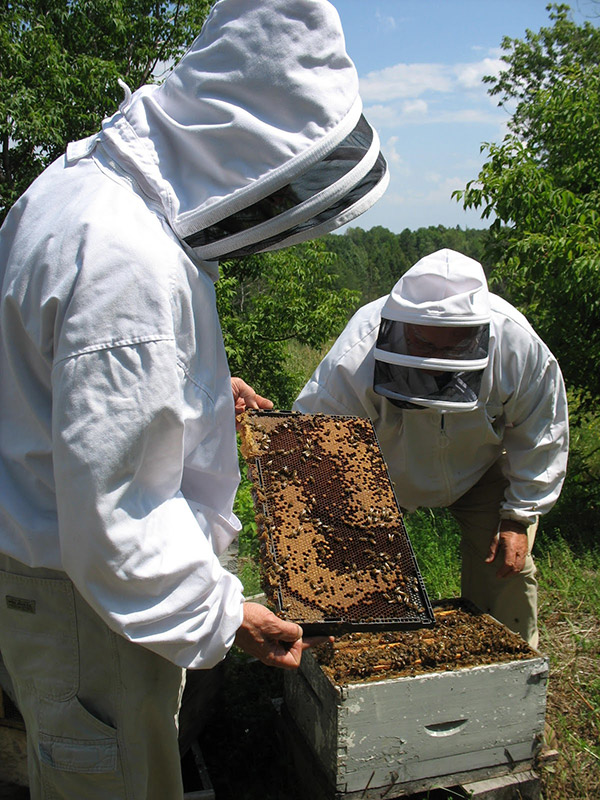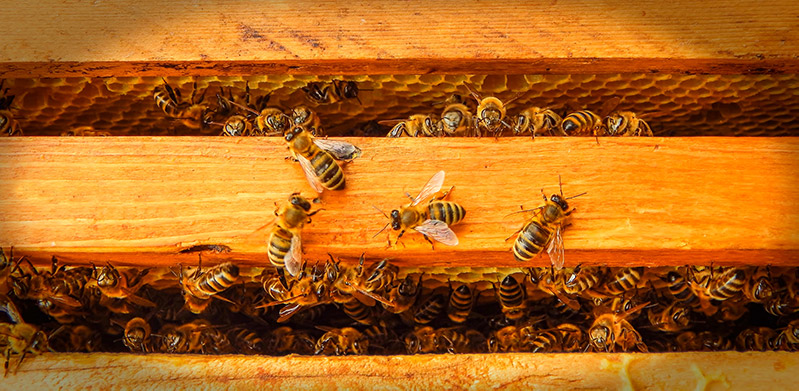What is American Foulbrood?
Industry
Page 06 /
Preventing American Foulbrood
Prevention of American Foulbrood
Biosecurity
The most important management strategy to protect your colony from American Foulbrood (AFB) is to practice excellent biosecurity.
Particular areas of concern include:
Beekeeping equipment:
- When moving between beeyards, it is important to ensure that the equipment is clean of spores. Hence, all tools should be scraped free of wax and propolis initially and then heated to a high temperature to destroy spores that may be present. This can be accomplished through the use of a propane torch to scorch the outside of the equipment
Gloves:
- Disposable gloves should be worn when working with colonies, and changed between as a method to prevent spores from coming into contact with an uninfected colony. Do not use leather or reusable gloves
Beekeeping suit and veil:
- While typically not a high-risk transmission point, ensure that your suit and veil are clean of wax and propolis at potential contact points with the colony.. Regularly wash and disinfect these pieces of equipment to prevent transmission of spores
Pollen:
- As beekeepers sometimes collect pollen to feed their colonies in periods of shortage, it is important to ensure that collection is made only from healthy colonies to prevent spore transmission
Honey:
- Do not feed honey to your colonies from outside sources
For more information on implementing biosecurity to protect your hives from a variety of diseases, read OMAFRA’s manual:
Essential Practices for Beekeepers in Ontario
Regulations
Beekeeping is regulated in Ontario and there are requirements for registration, inspection. and permitting. For more information, visit:
Overview of Beekeeping Regulations in Ontario: What you should know if you own honey bees
Preventative Antimicrobials
Use of oxytetracycline prophylactically (administering a medication to prevent a disease from occurring) when given to healthy colonies has been demonstrated to be effective at eliminating infection prior to spore formation. It is suggested that it may be most efficacious when antimicrobials are being provided in the spring and fall.
It is important to note that due to the common use of antimicrobials, the bacteria responsible for AFB has developed resistance to oxytetracycline in other Canadian jurisdictions. It is important to use antimicrobials responsibly to preserve their efficacy and prevent the development of resistance. Ensuring that all biosecurity measures are followed is also of critical importance to bee health. Some beekeepers provide a different antimicrobial, tylosin, in the fall as an additional method to prevent AFB. It is recommended that tylosin only be used in the fall due to the withdrawal times that are required to prevent contamination of honey.
Work with your veterinarian to develop a protocol that works best for your colony.
OMAFRA has developed a guide for beekeepers to manage honey bee pests and diseases:
Ontario Treatment Recommendations for Honey Bee Disease and Mite Control
Genetics
Obtaining strains of honey bees that are better able to fend off AFB is an additional strategy that has been proven to be successful1. Certain strains of honey bees have an increased social immune response and can be selected for improved hygienic behaviour toward infected larvae to prevent AFB.
For more information on prevention and management of AFB, check out OMAFRA’s page:
American Foulbrood – Prevention and Management
Take Home Messages
AFB is an economically important and devastating bacterial disease affecting bees worldwide. It is important to recognize signs of AFB quickly to prevent the spread of the disease. Biosecurity, prophylactic antimicrobials, and improved genetics can all limit the transmission of AFB into your colony. Work with your veterinarian to develop an effective strategy for you and your colony.
References
- Genersch, E. 2010. American Foulbrood in honeybees and its causative agent, Paenibacillus larvae. J Invertebrate Pathology. 103:10-19.
- Foulbrood in honey bees: A synthesis and proposed analytical protocols. Letters in Applied Microbiology. 43:583-590.
- USDA. Role of veterinarians in honey bee health.
- Reybroeck, W., E. Daeseleira, H.F. De Brabander, and L. Herman. 2012. Antimicrobials in beekeeping. Veterinary Microbiology. 158:1-11.

